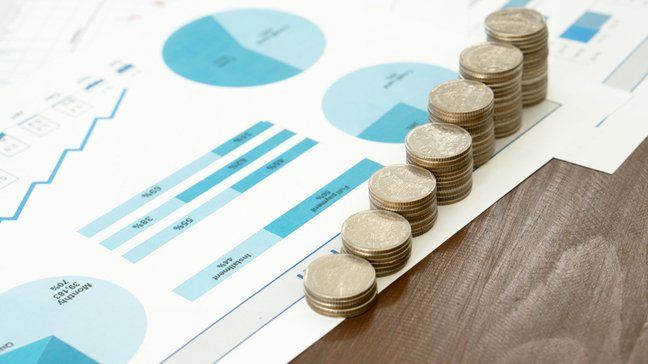When you come into, or have, a lump sum of cash like an inheritance, do you think about investing it with one of the best investment accounts? If you don’t – you really should. But there are different strategies you can employ with a large sum of money. You could spread it out over time, or dump it all into the stock market right away.
But which method is best for your returns and peace of mind?
In this article, I will review the difference between dollar-cost averaging (DCA) and lump-sum investing so you can determine which is best for you.
What is the difference between dollar-cost averaging and lump sum investing?

The main difference between dollar-cost averaging and lump sum investing is when you invest in the stock market. With dollar-cost averaging, you invest small amounts of your money at certain intervals over the course of time. Lump-sum investing, on the other hand, is when you take all of the money you have available to invest at that moment, and invest it all at once.
I’ll discuss these in a little more detail below.
Brief description of dollar-cost averaging
Investing your money at regular intervals – such as weekly, monthly, or quarterly – in things like stocks and ETFs is considered dollar-cost averaging (often referred to as DCA). Most of us have set up a 401(k) contribution at our jobs, and money is automatically taken out of our paychecks and invested in a variety of funds. If you’ve done that, you’ve used dollar-cost averaging.
While that is the most common method of dollar-cost averaging, you can take another route with dollar-cost averaging. If you have a lump sum of cash in a savings account, for example, you can elect to spread that money out over a certain period of time and invest it gradually. For example, if you had $20,000 you wanted to invest from your savings, you could spread that out over the course of 12 months (evenly) instead of investing it all at once.
The major draw to this strategy is that you aren’t putting every dollar you have into the stock market at once and taking the risk that the market will suddenly drop, and so will your portfolio’s value. Since past performance is nothing more than a piece of data and no one can predict future returns, dollar-cost averaging helps you mentally invest your money into riskier investments (like stocks) without “feeling” the risk as much.
Brief description of lump-sum investing
Lump-sum investing, on the other hand, is when you take all of your available dollars to invest and put it right into the stock market. It’s the opposite of dollar-cost averaging, so you don’t wait to invest – it all goes into your chosen investments right away. Now, there is somewhat of a fine line between DCA and lump-sum investing. Let me explain.
If you’re intentionally holding on to cash to invest it later, I would chalk it up as dollar-cost averaging. But you can still make periodic investments and consider it a lump sum investment. For example, say you get a quarterly bonus for $10,000. Every time you get that bonus, you decide to invest it. This is still lump-sum investing, even though you’re making periodic investments. The reason is that you’re not intentionally holding onto the money for a later time. You’re investing when you have it.
If you were to instead take the $10,000 quarterly bonus and spread it out over the coming quarter, in three equal monthly installments, THAT would be dollar-cost averaging. It might seem like semantics, but when you look at the data, the difference can actually mean more or less money in your portfolio (more on this below).
Who is dollar-cost averaging for?

Dollar-cost averaging works really well for nervous investors with lower risk tolerance and who have larger sums of money sitting around in something like a high-yield savings account. You can minimize your risk by spreading out your investment into smaller chunks, while still keeping cash in a safer investment, such as a certificate of deposit (CD).
You’ll also benefit from dollar-cost averaging if you can spread your investment out for a longer period of time. If you invest your money too quickly (for example, over three to six months), you may not give the market enough time to correct itself after a big upswing or downswing.
I recommend spacing it out over 12 to 36 months if you’re taking this approach to take into account volatility. Also, I recommend setting it up as an automated investment plan so you don’t bail out on your contributions by doing it manually.
On the flipside, DCA isn’t for those who want to invest faster, are okay with the ups and downs of the market, and don’t like keeping extra cash in lower-yield vehicles like bonds.
Who is lump-sum investing for?
Lump-sum investing is a strategy that requires a high level of risk tolerance. It’s taking a gamble. If you have $20,000 to invest, a lump sum investing strategy would tell you to dump all of that money into your investments at once. By doing that, you run the risk that the stock market can tank immediately. Alternatively, it can go upward, and you win out – hence the reason it’s a gamble.
A great example of this is early 2020 with the Coronavirus pandemic: if you invested in February you would have seen a quick move down and wondered what to do when the market plunged, but if you invested in late March your investment quickly shot upwards after. Both turned out to be great periods to put money in the market, but comparing the two you can see how lump-sump can provide a whole different set of returns even just weeks apart. You have to be comfortable with that.
So if you have money to invest and you’re okay with the idea that you could lose that money, and you’re willing to take that risk, then lump-sum investing is a great option for you. While there is an inherent risk, there’s also the possibility of huge gains. The goal is to just get the money in the market and let it go to work.
Likewise, if you’re uncomfortable with the risk of losing your investment, or if you want to have some extra cash set aside for an emergency fund instead of it being invested, lump-sum investing probably isn’t for you. Even if you could bring yourself to make the investment, people who are internally uncomfortable with it will experience anxiety and make emotionally-based trading decisions – which is never good.
Does it matter if you DCA or lump-sum?
Yes and no. No, it doesn’t matter from a personal and psychological perspective, but YES it does matter from a data and mathematical perspective. Here’s what I mean:
I like to equate this argument to Dave Ramsey‘s argument: the Debt Snowball. Mathematically, the Debt Snowball makes no sense. Ramsey suggests paying off your smallest balance first, then the next biggest one, and so on. This approach ignores interest rates, so you’re not necessarily taking the most logical approach – but it works on a psychological level.
That, to me, is where dollar-cost averaging wins out over lump-sum investing. Mathematically, it doesn’t necessarily make sense (I’ll tell you why in a moment), but it brings a level of psychological safety to your investment strategy by allowing you to keep cash on hand in case of an emergency AND invest some money along the way.
What the studies show
Just like any investment strategy that aims to reduce risk (like investing in bonds, for example), dollar-cost averaging has downsides. Put simply, a dollar-cost averaging investor will miss out on massive swings in the market because they’re keeping their money aside for the next cadenced deposit toward that investment. By the time the money is ready to be invested, the market may have already corrected itself and you’ve missed out on the gain.
One study done by professors of finance, Richard E. Williams and Peter W. Bacon, in the early 90s, looked at historical stock market data, spanning around 70 years. Their findings showed that around 67% of the time, someone who invests a lump sum gained higher returns in their first year than someone who followed dollar-cost averaging and drip-fed their investment over the course of the year.
Another study by Vanguard that was done more recently, looked at the difference between dollar-cost and averaging and lump sum investing by investing in a 60/40 (stock/bond) portfolio in three different countries. They found that in each market, a lump-sum investment led to greater portfolio values approximately two-thirds of the time. They did variations of this test and saw very similar results, too.
Finally, a study done by Robert Atra and Thomas Mann in 2001 in the Journal of Financial Planning states that “The results (of various studies) suggest that DCA is neither as effective as the personal finance literature claims, nor as suboptimal as the academic literature claims.”
What they’re saying is that dollar-cost averaging, from a statistical perspective, isn’t all it’s cracked up to be. It provides some level of safety and peace of mind, but at the cost of increased returns.
Choosing a good broker to invest with

Whether you choose to use dollar-cost averaging or lump sum investing is up to you. But regardless of the method you choose, you need to make sure you’re using one of the best online brokerage accounts. Here are couple of my favorites right now:
J.P. Morgan Self-Directed Investing
J.P. Morgan Self-Directed Investing gives you an option to invest on your own, or with J.P. Morgan Automated Investing. Both account types come with easy account management, best-in-class expertise from J.P. Morgan Chase, and integration with a variety of Chase features.
When it comes to dollar-cost averaging, you can use either account type. J. P. Morgan Self-Directed Investing will allow you to pick your own stocks and invest over time without paying commissions. J.P. Morgan Automated Investing, on the other hand, will let you build a managed portfolio that you can drip money into on a periodic basis.
For lump-sum investment, J.P. Morgan Self-Directed Investing is great since you won’t have to pay commissions.
Robinhood
Robinhood is one of the best commission-free online trading platforms that lets you apply your chosen strategy and invest in stocks and ETFs with as little as $1.
Fractional shares, which are partial shares, with Robinhood allow you to DCA even if you’re starting to invest with little money. It means you can slowly buy into Apple, for instance DCA at $10 per week over a set period of time, or lump-sump invest a total amount even if it’s not enough for a full share or doesn’t divide perfectly into whole shares. The same stands for ETFs.
E*TRADE
E*TRADE is far and away one of, if not the, best investment platforms you can be on. They blow most other online brokers away with the number of tools and resources they have, the advanced investment charts you can leverage, and their unique account features. They aren’t the cheapest, but if you’re a serious long-term investor, give E*TRADE a look.
What’s great about E*TRADE for dollar-cost averaging is the fact they have E*TRADE, where you can get a checking or savings account. So not only can you space out your investments, but you can keep the cash in a high-yield savings account while you wait to invest it – all with one broker. And for lump-sum investing, things like the Technical Pattern Recognition Tool and Spectral Analysis will potentially help you make the right investment the first time.
Summary
So while the data suggest that lump-sum investing is a better strategy in the long-run, it doesn’t necessarily mean it is going to be the best strategy for you. Investing is emotional – and as long as you keep those emotions in check and avoid making rash decisions, you should be fine.
But part of that emotion is feeling secure in what you’re investing in – which is when DCA might prove valuable for you. Either way, make sure you know the differences and find a broker that will work for what you need.